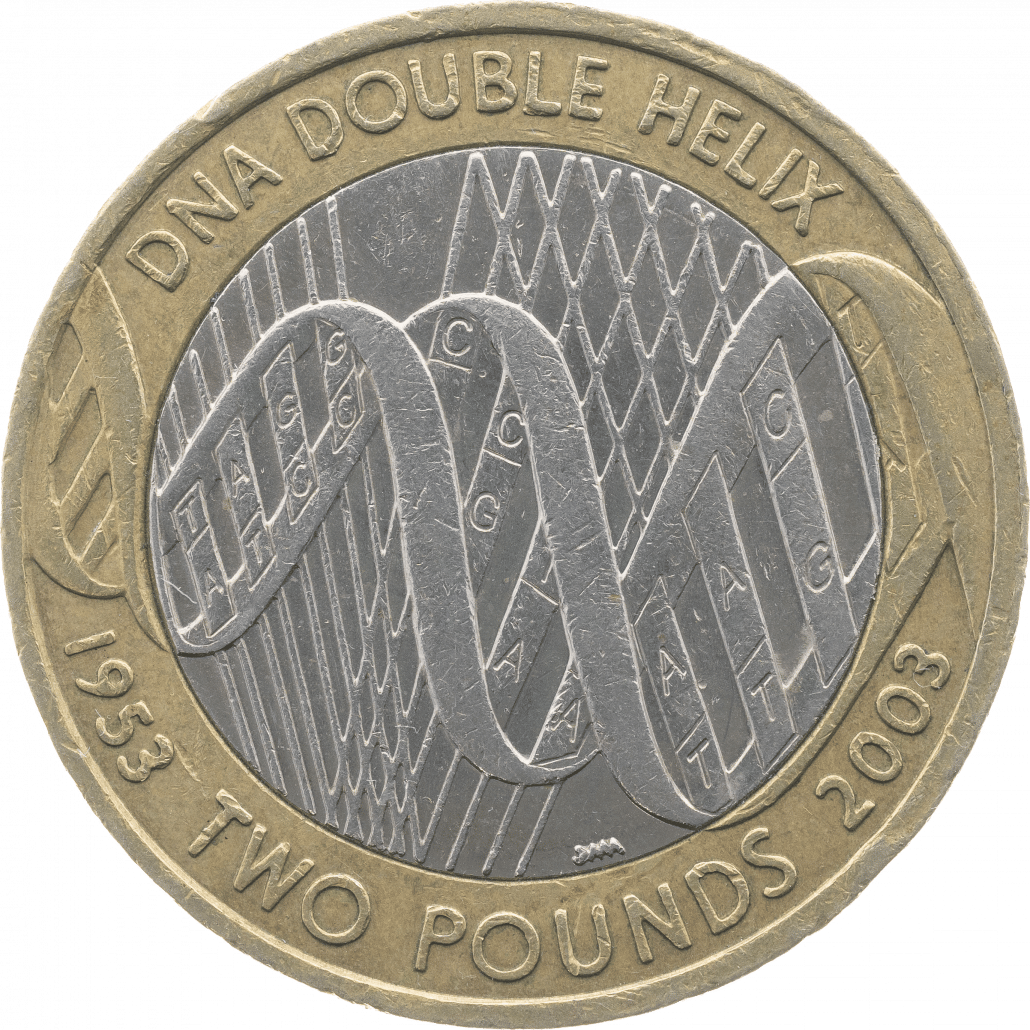If you are an avid coin collector there is no doubt you will have come across a DNA £2 coin, also known as the double helix £2 coin, but how much are they worth today and are they rare?
The 2003 DNA £2 coin is worth £2.84 on average according to past sold values on eBay in circulated condition without postage.
Let’s take a look at the mintage of the coin, as well as the design, to see why it is worth this much.
DNA £2 Mintage
There were 4,299,00 DNA £2 coins minted for circulation in 2003, and this was the only commemorative £2 coin released this year. This was also the same year that the Suffragettes 50p was introduced.
There were also uncirculated versions that were released for collectors by the Royal Mint, a common practice for commemorative coins, for which the mintage figures can be seen below:
- A Silver Proof version with a 25,000 mintage
- A Silver Proof Piedfort mintage of 10,000
- A Brilliant Uncirculated £2 Coin with a limited 41,568 issued worldwide in a presentation pack
- A Gold Proof mintage of just 1,500
Mintage is one thing, but how rare is the coin in practice?
How Rare Is The DNA £2?
In terms of mintage, the DNA £2 coin is the 18th rarest £2 coin in circulation. For some comparison, the rarest £2 coin in circulation currently is the Commonwealth Games Ireland £2 with a mintage of 485,000 which was introduced the year before in 2002.
A mintage of over 4 million is comparable to some other popular £2 coins such as the Shakespeare £2 coins and the Trinity House £2 coin.
It’s also important to take into account the fact that the coin was introduced in 2003, so it has been in circulation for almost 20 years now which means many coins may have already been collected or simply discarded.
The Design Of The 2003 DNA £2 Coin
The design of this special commemorative 2003 £2 DNA coin is the work of John Mills. It features a double helix structure of a DNA molecule which represents the discovery of DNA to mark the 50th anniversary of the momentous scientific event.
If you look closely at the molecule strands, you will notice the letters A C G and T on the strands of chromosomes. On the coin’s design, these four letters are read from left to right, and top to bottom as TAGGCCTAACT on top and ATCCGAATTGA on the bottom as the double helix curves.

These letters are notations for the four basic building blocks or genetic code that form amino acids and create protein. ACGT is an acronym for the four types of bases found in a DNA molecule. They include Adenine, Cytosine, Guanine, and Thymine. Additionally, Adenine always pairs with Thymine and Cytosine pairs with Guanine.
In humans, these base pairs create chromosomes. The sequence of the bases inside the DNA molecule, also called a gene, is what delivers instructions that are the building blocks of assembling a protein that is at the beginning of life and makes us who we are.
Look even closer, and you will see the initials of the designer, JM, located just above the word POUNDS.
On the outer circle of the coin’s reverse side, just above the DNA molecule, are the words DNA DOUBLE HELIX. Just below the DNA molecule are the dates 1953 and 2003 on either side of the words TWO POUNDS.
The milled edge reveals the inscription, DEOXYRIBONUCLEIC ACID
What Does The 2003 DNA £2 Coin Represent?
DNA is the molecule that provides genetic information for all growth, development, functioning, and viruses of all living organisms. It contains the genetic codes that make us who we are.
In a Cambridge University laboratory in 1953, Francis Crick and James Watson, along with the help of Rosalind Franklin, noticed something that would change the way we understand biological science. They had discovered a twisted strand of deoxyribonucleic acid, what we know today as DNA.
When the two noticed a twisted strand of DNA that was intertwined in such a way that it was able to pull apart, replicate itself, and pass their genetic code from old cells to new ones, they probably had no idea of how their discovery was about to change the world.
The unfolding of DNA actually began years before Francis Crick and James Watson discovered the molecular structure and identified it. Before these two students made their discovery, DNA had actually been discovered and isolated long before. In 1869 by Friedrich Miescher.
However, the molecular structure would later be identified by James Watson and Francis Crick in 1953 with the help of data acquired by an X-Ray Physicist Raymond Gosling.
Are There Any Error Versions?
There are no confirmed errors for the DNA £2 coin, although many eBay sellers would like you to believe that there are.
There are some cases of misaligned dots on the obverse side of the coin, however, this is a common occurrence on all pre-2015 £2 coins and is therefore not considered to be an error.
Another ‘error’ is the edge inscription DEOXYRIBONUCLEIC ACID appearing upside down, however the edge inscription can occur either way around on any £2 coin and so this is yet another false error.
Where Can You Buy The Coin?
For circulated versions your best bet is to go to eBay, but watch out for error listings as well as high postage and packaging prices.
If you want an uncirculated version, such as BU or gold proof, then you will need to check a coin dealership. The Royal Mint has a great online store, as well as other places like Chards, so it is worth looking at these places for a starting point.
